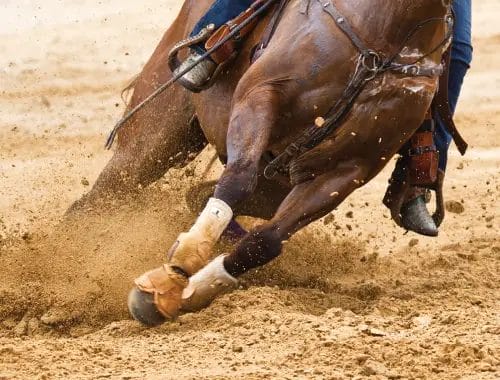If you have recently received an Osphos injection, it is important to consider certain factors before riding a horse. Osphos is a medication commonly used to treat bone-related issues in horses. After the injection, it is recommended to allow the horse a period of rest and recovery. It is crucial to follow your veterinarian’s advice regarding the horse’s activity level. Consulting with your vet will help determine when it is safe to resume riding or any strenuous activities with the horse.

How does Osphos Injection Affect Riding Ability?
Osphos injection is a medication commonly used in equine medicine to treat horses with navicular syndrome. Navicular syndrome is a condition that causes lameness in horses and can significantly impact their riding ability. However, Osphos injection has shown promising results in managing the symptoms of this condition and improving the horse’s riding ability.
When administered, Osphos injection works by targeting the bone resorption process, which is elevated in horses with navicular syndrome. The active ingredient in Osphos, clodronate, inhibits the activity of the osteoclast cells responsible for breaking down bone tissue. By reducing bone resorption, Osphos helps to slow down the progression of the disease and alleviate the associated pain and lameness.
Improved riding ability is one of the key benefits observed in horses receiving Osphos treatment. The medication helps to reduce inflammation and pain in the navicular region, allowing the horse to move more comfortably and with greater ease. This can lead to improved performance, as the horse is able to execute movements with less discomfort and increased flexibility.
Furthermore, Osphos injection has been reported to have long-lasting effects on riding ability. Studies have shown that the beneficial effects of Osphos can last for several months after a single injection. This is particularly advantageous for horses engaged in competitive disciplines, as it allows them to maintain optimal performance levels over an extended period.
It is important to note that while Osphos injection can significantly improve riding ability in horses with navicular syndrome, it is not a cure. The medication helps to manage the symptoms of the condition and slow down its progression, but it does not address the underlying cause. Therefore, it is crucial to combine Osphos treatment with proper hoof care, shoeing techniques, and a tailored exercise program to ensure the best possible outcomes for the horse.
In summary, Osphos injection has a positive impact on riding ability in horses with navicular syndrome. By reducing inflammation, pain, and bone resorption in the affected area, Osphos helps to alleviate lameness and improve the horse’s overall performance. Its long-lasting effects make it an attractive treatment option for competitive horses, allowing them to maintain optimal riding ability for an extended period. However, it is important to remember that Osphos is not a cure and should be used in conjunction with other management strategies for the best results.

Tips for Safely Riding a Horse Following an Osphos Injection
After your horse has received an Osphos injection, it is important to follow certain guidelines to ensure their safety and well-being during riding activities. Osphos is a medication used to treat bone diseases in horses, specifically conditions related to the formation of excess bone. It is essential to take precautions and make adjustments to your horse’s routine to prevent any complications or discomfort during riding. Here are some tips to help you safely ride your horse following an Osphos injection:
1. Allow Sufficient Recovery Time
It is crucial to give your horse enough time to recover from the injection before engaging in any strenuous activities such as riding. The exact recovery time can vary depending on the individual horse and the specific condition being treated. It is recommended to consult with your veterinarian to determine when it is safe to resume riding. Rushing into riding too soon can put unnecessary stress on your horse’s body, potentially leading to further complications.
2. Monitor for Any Adverse Reactions
Pay close attention to your horse’s behavior and physical condition following the Osphos injection. Look out for any signs of discomfort, such as lameness, swelling, or sensitivity around the injection site. If you notice any concerning symptoms, contact your veterinarian immediately for further guidance. It is better to err on the side of caution and seek professional advice when in doubt.
3. Gradually Resume Exercise
Once your horse has been cleared by the veterinarian, start by gradually reintroducing light exercise routines. Begin with short walks or light lunging sessions to allow your horse’s body to gradually adjust to the increased activity. This gradual approach will help prevent strain or stress on the bones and muscles.
4. Warm-Up and Cool-Down
Prior to riding, ensure that you warm up your horse properly to prepare their muscles and joints for the physical exertion. Incorporate stretching exercises and gentle movements to promote flexibility and reduce the risk of injury. Similarly, after your ride, allow your horse to cool down adequately by walking them out and performing some post-ride stretching exercises. Cooling down helps the horse’s body return to a resting state and aids in preventing stiffness and muscle soreness.
5. Regular Veterinary Check-ups
Maintaining regular check-ups with your veterinarian is essential for the overall well-being of your horse, especially after receiving an Osphos injection. These check-ups will help monitor the progress of the treatment and ensure that your horse’s condition is improving as expected. Your veterinarian may also provide additional recommendations or adjustments to your horse’s exercise routine based on their specific needs.
By following these tips, you can help ensure the safe and comfortable riding experience for your horse after they have received an Osphos injection. Remember, the health and well-being of your horse should always be a top priority, so consult with your veterinarian for personalized advice and guidance.

Common Precautions and Riding Guidelines After Osphos Injection
Osphos is a medication used in horses to treat certain conditions such as navicular syndrome and other bone-related issues. After your horse receives an Osphos injection, it is important to take some precautions and follow specific riding guidelines to ensure their safety and well-being.
1. Rest and Recovery
After your horse receives an Osphos injection, it is crucial to allow them sufficient rest and recovery time. The medication works by inhibiting bone resorption, which can cause temporary discomfort or soreness in the injected area. It is recommended to give your horse at least 48 hours of rest following the injection to allow their body to adjust to the medication and for any potential side effects to subside.
2. Monitor for Adverse Reactions
While Osphos is generally safe and well-tolerated by most horses, it is important to monitor for any adverse reactions or side effects. Keep a close eye on your horse for the first few days after the injection and watch for signs such as excessive lameness, swelling, or discomfort. If you notice any concerning symptoms, contact your veterinarian immediately.
3. Gradual Return to Work
Once the initial rest period is over, you can gradually reintroduce your horse to work and riding. Start with light exercise and gradually increase the intensity and duration over time. This gradual approach allows your horse’s body to adapt to the medication and reduces the risk of any potential complications.
4. Proper Warm-up and Cool-down
Before and after each ride, make sure to provide your horse with a proper warm-up and cool-down routine. This helps to loosen their muscles, improve circulation, and prevent any additional strain or injuries. Take your time when warming up and cooling down, allowing your horse to stretch and warm up their muscles properly.
5. Regular Veterinary Check-ups
It is important to schedule regular check-ups with your veterinarian to monitor your horse’s progress and ensure that the Osphos treatment is effective. Your vet will assess your horse’s condition, evaluate their response to the medication, and make any necessary adjustments to the treatment plan.
6. Follow Dosage Instructions
Always follow the dosage instructions provided by your veterinarian when administering Osphos to your horse. The proper dosage is based on your horse’s weight and the specific condition being treated. Administering the correct dosage is essential for optimal treatment outcomes and to avoid any potential side effects.
7. Maintain a Balanced Diet
Proper nutrition plays a vital role in your horse’s overall health and recovery. Ensure that your horse has a balanced diet consisting of high-quality hay, fresh water, and appropriate supplements if recommended by your veterinarian. A well-nourished horse has a stronger immune system and is more likely to recover faster.
8. Provide Adequate Turnout
Allowing your horse regular turnout in a safe and spacious paddock or pasture is beneficial for their physical and mental well-being. Movement and access to natural grazing help with circulation, joint mobility, and general fitness. However, avoid excessive exercise or strenuous activities that may put additional strain on your horse’s bones and joints.
9. Communicate with Your Veterinarian
Throughout your horse’s treatment with Osphos, it is important to maintain open communication with your veterinarian. Discuss any concerns or questions you may have regarding your horse’s progress, behavior, or any changes you observe. Your veterinarian is the best resource for guidance and can provide tailored advice specific to your horse’s needs.
Summary
After your horse receives an Osphos injection, it is crucial to prioritize their rest and recovery. Monitor for adverse reactions and gradually reintroduce them to work and riding. Follow proper warm-up and cool-down routines, and schedule regular check-ups with your veterinarian. Adhere to the recommended dosage, maintain a balanced diet, and provide adequate turnout for your horse’s well-being. Effective communication with your veterinarian is key throughout the treatment process.
Managing and Monitoring Riding Activities Post Osphos Injection
Osphos is a commonly used medication in equine medicine to treat horses with bone and joint issues. After administering Osphos to your horse, it is important to carefully manage and monitor their riding activities to ensure their optimal health and recovery. In this section, we will discuss the steps you need to take to manage and monitor your horse’s riding activities post Osphos injection.
1. Follow Veterinarian’s Instructions
First and foremost, it is crucial to follow your veterinarian’s instructions regarding the post-injection care of your horse. They will provide you with specific guidelines based on your horse’s condition and treatment plan. These instructions may include restrictions on riding activities and duration.
2. Allow Adequate Rest
After an Osphos injection, your horse may need some time to rest and recover. It is important to allow them adequate rest to ensure proper healing and avoid any unnecessary strain on their bones and joints. Restricting riding activities during this rest period is essential.
3. Gradually Increase Activity
Once your horse has had sufficient rest, you can gradually increase their activity levels. Start with light exercises such as walking and trotting to assess their response and tolerance. Observe your horse for any signs of discomfort or lameness during these activities.
4. Evaluate Lameness
Regularly evaluate your horse for any signs of lameness or discomfort during riding activities. If you notice any abnormalities or changes in their gait, it is important to consult your veterinarian immediately. They can assess the situation and make necessary adjustments to the treatment plan.
5. Monitor Swelling or Inflammation
Keep a close eye on your horse’s legs and joints for any signs of swelling or inflammation. Swelling may indicate an adverse reaction or a need for further treatment. Contact your veterinarian if you notice any abnormal swelling or signs of discomfort.
6. Maintain a Proper Exercise Routine
Establish and maintain a proper exercise routine for your horse post Osphos injection. Regular exercise is essential for their overall health and well-being. However, it is important to strike a balance between providing enough exercise and avoiding excessive strain on their bones and joints.
7. Regular Veterinary Check-ups
Schedule regular check-ups with your veterinarian to monitor your horse’s progress post Osphos injection. They can assess the effectiveness of the treatment and make any necessary modifications to ensure the best possible outcome for your horse.
8. Communicate with Your Veterinarian
Open communication with your veterinarian is key in managing and monitoring your horse’s riding activities post Osphos injection. Keep them informed about any changes or concerns you may have, and follow their advice and recommendations diligently.
In summary, managing and monitoring riding activities post Osphos injection involves following your veterinarian’s instructions, allowing adequate rest, gradually increasing activity, evaluating lameness, monitoring swelling or inflammation, maintaining a proper exercise routine, scheduling regular check-ups, and communicating with your veterinarian. By taking these steps, you can ensure the well-being and recovery of your horse after Osphos treatment.
FAQs
Can you ride a horse after an Osphos injection?
It is generally recommended to avoid riding a horse for at least 48 hours after an Osphos injection. This allows time for the medication to take effect and reduces the risk of injury or discomfort for the horse.
Are there any side effects of Osphos injection?
Common side effects of Osphos injection may include mild lameness, swelling or heat at the injection site, and gastrointestinal disturbances. It is important to consult with a veterinarian for specific information and guidance based on your horse’s individual situation.
How often should Osphos injections be given?
The frequency of Osphos injections depends on the horse’s condition and response to treatment. In general, a single injection is recommended initially, followed by additional injections as needed. Your veterinarian will determine the appropriate treatment plan for your horse.
Conclusion
In conclusion, after receiving an Osphos injection, it is important to consider certain factors before riding a horse. While Osphos is a medication commonly used to treat bone conditions, it may cause temporary side effects such as muscle soreness, stiffness, or weakness. It is recommended to give the horse some time to recover and for the medication to take full effect before engaging in any strenuous activities like horse riding.
Additionally, it is crucial to consult with a veterinarian regarding the specific condition being treated and for their professional advice on when it is safe to resume riding. Prioritizing the horse’s well-being and allowing sufficient time for healing will help ensure a safe and successful riding experience.
